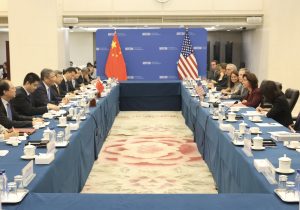Shannon Tiezzi

From August 27-30, U.S. Commerce Secretary Gina Raimondo was in Beijing and Shanghai for talks with her Chinese counterparts. Raimondo met with Chinese Premier Li Qiang, Vice Premier He Lifeng, and Minister of Culture and Tourism Hu Heping, in addition to her direct counterpart, Minister of Commerce Wang Wentao.
Her visit was part of a broader trend of re-engagement at the official level between the Chinese and U.S. governments. Starting with U.S. Secretary of State Anthony Blinken’s visit to China in mid-June, four Cabinet-level officials from the United States (Blinken, Treasury Secretary Janet Yellen, climate envoy John Kerry, and now Raimondo) have traveled to China.
Prior to any of those trips, however, China’s commerce minister had visited the United States in late May to attend an Asia-Pacific Economic Cooperation (APEC) meeting in Detroit. Wang met with U.S. Trade Representative Katherine Tai there before traveling to Washington. D.C. for talks with Raimondo.
The two commerce ministers reunited in Beijing on August 28. The difference in the readouts – and, by implication, the discussions – was striking.
After the Raimondo-Wang talks on May 25, the U.S. Commerce Department issued a brief, one-paragraph note stating that the two officials “had candid and substantive discussions on issues relating to the U.S.-China commercial relationship, including the overall environment in both countries for trade and investment and areas for potential cooperation.” There were no specifics on either “areas of potential cooperation” or the “concerns” that Raimondo was said to have raised about “actions taken” against U.S. businesses operating in China.
The readout following the August 28 meeting in Beijing was much longer, including concrete outcomes. According to the U.S. Commerce Department, the two sides agreed to set up four new frameworks for interaction. First, there’s a “new commercial issues working group,” which will meet twice a year at the vice minister level beginning “in early 2024.” The group was described as “a consultation mechanism involving U.S. and PRC government officials and private sector representatives to seek solutions on trade and investment issues.”
Second, there is a new “export control information exchange” platform, also at the vice minister level, which held its first meeting on August 29.
Both sides also agreed, although with less specifics on frequency, to “convene subject matter experts from both sides” to talk about ensuring trade secrets and other confidential information are protected “during administrative licensing procedures.”
Finally, there was a commitment to hold in-person meetings between the commerce ministers “at least once annually.”
Of these, the “export control information exchange” is arguably the most interesting. U.S. export controls on crucial technology – most notably semiconductors, and the machines needed to make them – are “serious concerns” for Beijing, as Wang told Raimondo. According to the Chinese Ministry of Commerce, Wang said that “overgeneralization of national security is not conducive to normal trade and economic exchanges,”and that “unilateral and protectionist measures…will only disturb the security and stability of global industrial and supply chains.”
Wang complained specifically about “Section 301 tariffs on Chinese exports, semiconductor policies, two-way investment restrictions, discriminatory subsidies, and sanctions targeting Chinese companies.”
Raimondo also acknowledged in public remarks that her Chinese hosts repeatedly raised the issue of export controls. Yet she said she made it clear that the Biden administration will push forward regardless. “Their asks were to reduce export controls on technology” and retract President Joe Biden’s recent order restricting U.S. investment in Chinese advanced technology companies, Raimondo told reporters, as quoted by the Associated Press.
“Of course, I said no. We don’t negotiate on matters of national security,” she continued.
Raimondo was clear that export controls are not going away, so what can an “information exchange” platform really hope to accomplish?
The U.S. readout described the framework as “platform to reduce misunderstanding of U.S. national security policies.” U.S. officials have consistently denied that the export controls are meant to artificially contain China’s economy, instead insisting that the restrictions are as “narrowly targeted” as possible to protect U.S. national security interests or human rights concerns (in the Biden administration’s parlance, a “small yard, high fence” approach). The export control mechanism may be an attempt to convince China on that front, but if so it’s hard to see how the platform will function as anything other than a channel for Beijing to lobby for certain restrictions to be diluted or scrapped.
Meanwhile, China has also begun to add export controls of its own, as a tit-for-tat measure to respond to U.S. restrictions. Presumably the “information exchange” would also help provide clarity to Beijing’s moves, but that’s not included in the current description.
As has been the case in all the recent China-U.S. meetings, “talking about talking” is essentially the best that can be hoped for. There is no signaling from either side that projects a course change on the most important issues, from China’s tech ambitions (and U.S. attempts to squash them) to the very shape of the international order. Barring that, the most the two sides can do is tinker around the margins to try to find some elusive way to “compete” with the other party without actually upsetting anyone.
That said, China has a reason to attempt to make nice in the economic sector specifically. Amid shaky economic data, the Chinese government has been ramping up efforts to boost foreign investment and bolster confidence in China’s private sector. Policymakers in Beijing undoubtedly hope to attract U.S. companies as part of that overall effort.
Despite recent tensions at the government level – and the intervening pandemic – total U.S. investment in China grew by $16.7 billion from 2019 to 2022, according to data from the U.S. Bureau of Economic Analysis. Over a longer time frame, U.S. FDI stocks in China grew by over one-third from 2016 to 2022.
No comments:
Post a Comment